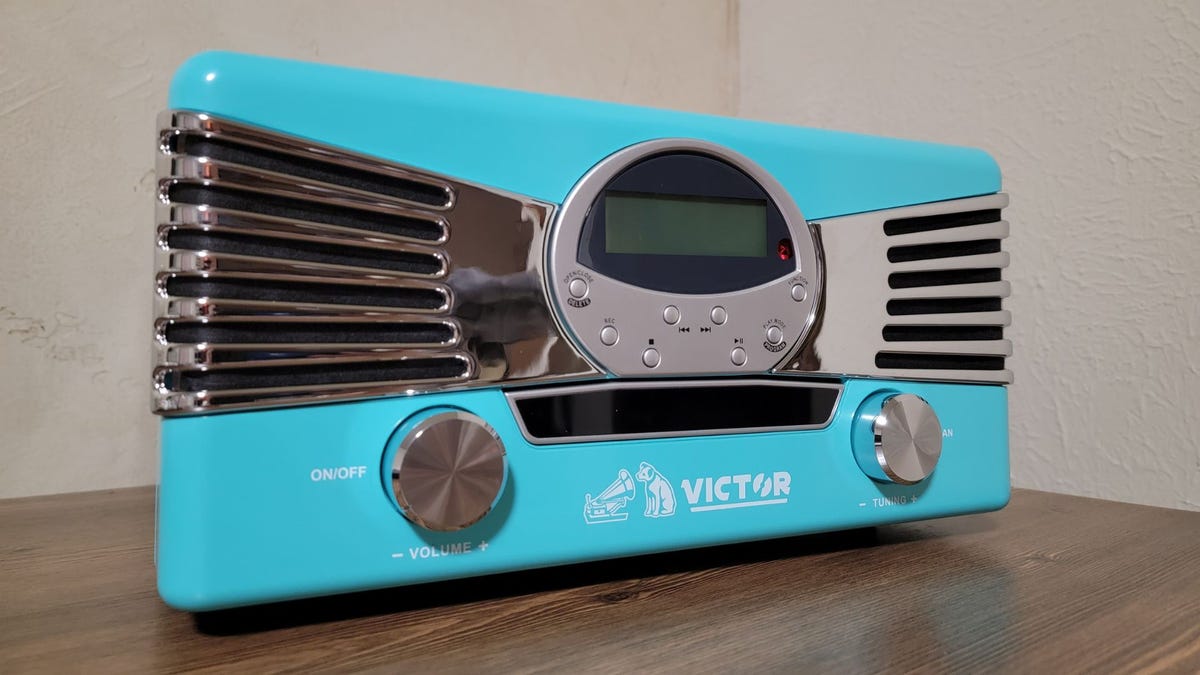
A real looker, though not an audiophile dream.
As a kid, I remember tirelessly collecting CDs from all my favorite artists because I wanted that physical experience of swapping out the disc. But alas, digital music took over. With Victor Audio’s Diner Hybrid Record Player, I can get the best of both worlds—physical and digital music.
Not only can you jam out to physical records on this retro cutie, you can also play music from your phone via Bluetooth, listen to the radio, or use an external Bluetooth speaker, among other sources. The bright turquoise might not be for everyone, but I absolutely love it and it makes me happy every time I look at it. Plus, there’s a black model if you prefer the muted look. While there were many things I enjoyed about this record player, there was a major annoyance I encountered during my testing experience.
Here’s What We Like
- Beautiful retro design
- Multiple ways to play music
- Speakers are decent, and easily fill a room
And What We Don’t
- Outer materials feel cheap
- I had distortion troubles
Review Geek’s expert reviewers go hands-on with each product we review. We put every piece of hardware through hours of testing in the real world and run them through benchmarks in our lab. We never accept payment to endorse or review a product and never aggregate other people’s reviews.
Specs As Reviewed
- Turntable Speed: 33 1/3, 45, 78 RPM
- AM/FM Frequency Range: 520 to 1710 KHz / 87.5 to 108 MHz
- AM/FM Station Memory: Up to 9 stations for both
- Bluetooth Info: Version 5.0, 2.402 GHz – 2.480 GHz frequency, up to 33 feet (10 meter) operating distance
- Inputs: USB, Line In (Aux In)
- Outputs: Line Out, Headphone Jack
- Speakers: 3-inch x 2
- Speaker Output Power: 2W x 2
- Power Consumption: 25W
- Accessories Included: Remote control (needs two AAA batteries), RCA cable, User Manual, Quick Set Up Guide
Setup and Connection Options
Because all the internals are already pre-set and ready to go, the setup process was painless. I didn’t have to tune or adjust anything, which I was thankful for. Before I could start listening to my newly purchased vinyl, there were only a few steps.
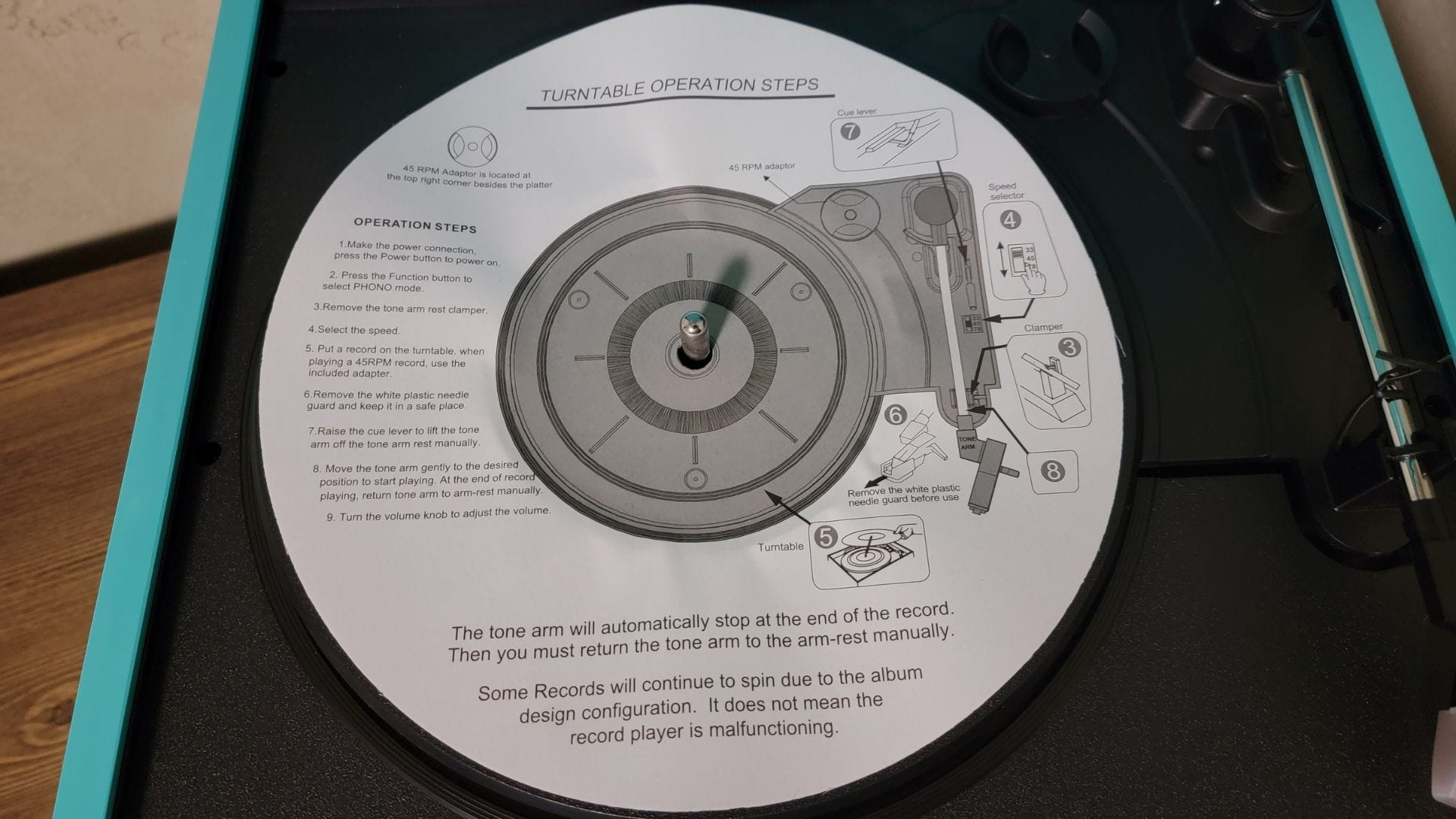
I had to find a good, level spot for the Diner record player, and Victor Audio’s recommendation is a sturdy surface away from any heat or water sources. Then, I removed the protective stylus cap and the twist tie from the tone arm, plugged it into the wall, and turned it on. And that’s it! If you choose to listen to the radio first, you’ll need to unwind the FM antenna wire for a proper signal.
At this point, I could put a record down and start playing music, only needing to adjust the volume to my preference. Although operating a record player seems an intuitive process, I always love to follow the included instructions to the letter just to ensure that they make sense for a novice or a pro.
The Function button needs to be set to “PHONO”—which is the default function when you first turn the record player on—and then, you’ll choose the proper speed and put your record on the turntable. There’s a black switch that you can move between the three available speeds: 33 1/3, 45, and 78 RPM.
Then, you use the cue lever to raise the tone arm, move it over your record, and lower it so it makes contact and starts playing. Both the cue lever and the tone arm are pictured and labeled so you clearly know which pieces you need to move.

Connecting my phone to the Diner via Bluetooth was equally simple. While the record player was turned on, I pushed the Function button until I saw “BT” display on the screen. Then, I used my phone to scan for available devices and paired them within seconds. After this initial pairing, all I had to do to stream music was turn the record player on and then find it in my Bluetooth devices.
You also have the option of pairing the Diner with an external Bluetooth speaker. The external speaker has to be set to pairing mode and then you press the Tuning/Scan button on the Diner’s front for about two seconds to start pairing. While the record player itself is silent after the connection is made, you can control the volume of your external Bluetooth speaker using the Diner’s volume knobs or the remote control. As soon as you switch to another function mode, Bluetooth automatically disconnects.
Design, Ports, and Buttons
The Diner Hybrid Record Player looks better than it feels. It’s made of a plastic material and at less than 10 pounds, it’s surprisingly lightweight. Despite this slightly cheaper build, the more mechanical components inside—like the tone arm, spindle, and actual turntable—feel like they’ll stand up to hours of use.
I absolutely love the classic design and the bright turquoise color. It’s reminiscent of a jukebox you’d find in an old, retro diner. There’s a turquoise dust cover on top that you can close while a record is currently playing or when it’s not in use. Dust is the enemy of any vinyl fan because it accumulates so quickly, and not all record players have a dust cover, so this was a win.
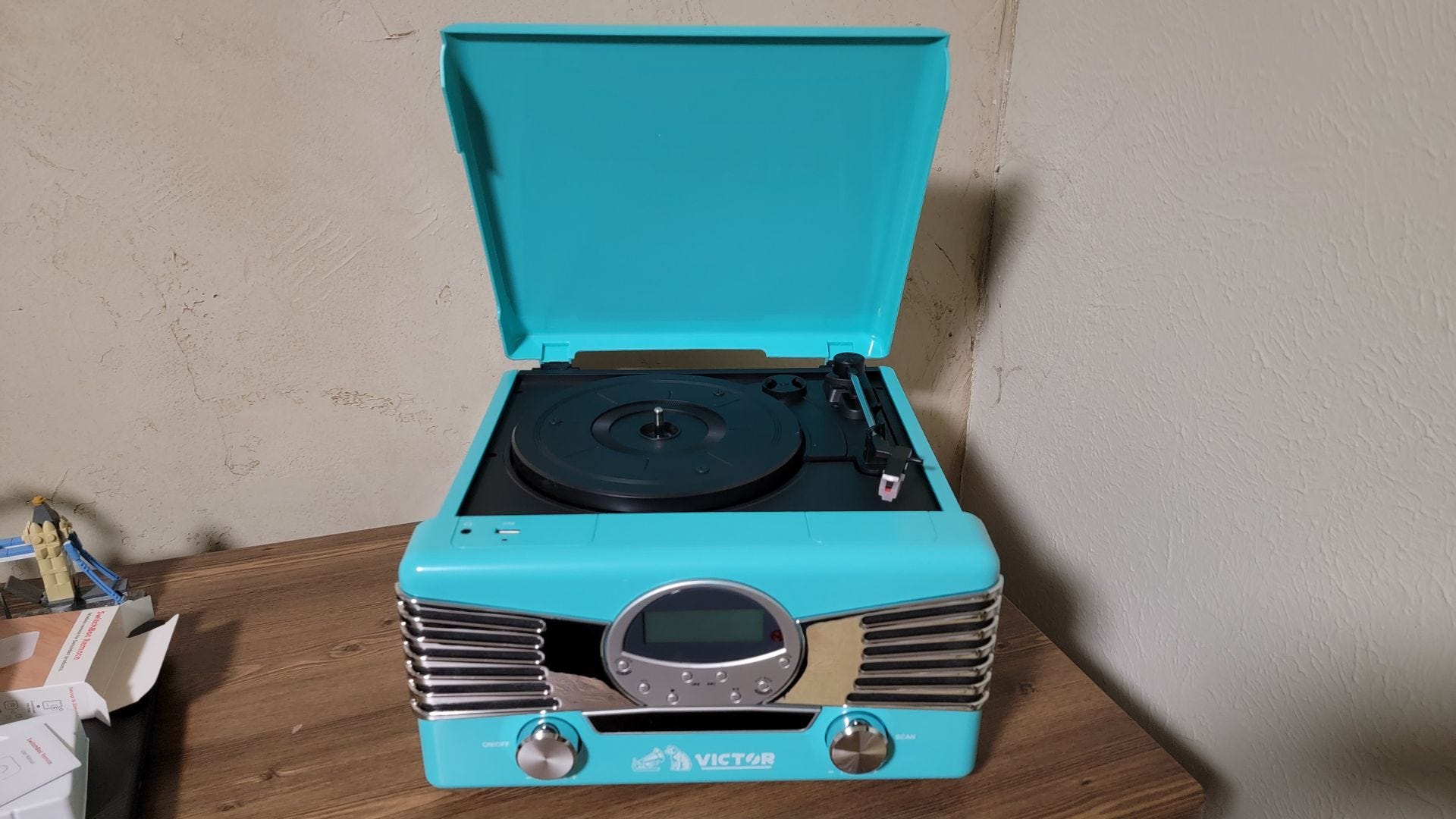
On the top left corner, there’s a headphone jack and a USB-A port in case you want to record some of your favorite songs to a flash drive. Then, the back of the record player is covered in a black particle board, and there’s an FM wire antenna, a line-in (or aux-in) jack, a line-out jack, and an AC power cord that plugs into a wall outlet.
You’ll mostly end up using what’s on the front display of the Diner, where the screen, knobs, and buttons live. There are two knobs—one on the left, and one on the right—and they can both be turned and pressed in. The left knob controls the volume when it’s turned, and powers the record player on and off when it’s pressed in. The right knob scans for radio stations when it’s turned and you’re in FM or AM mode, and goes into pairing mode when you long press it for about two seconds.

Using the Function button, you can swap between the Diner’s seven unique modes: Phono, Bluetooth, Aux, USB, AM, FM, and CD. When you want to play records, the Diner needs to be in Phono mode, and the Function button and left knob are all the controls you’ll need. All of the other buttons only apply to the six remaining modes.
When you’re listening to music via a CD, CD-MP3, USB, Bluetooth, or an aux cable, you can use the Previous Track/Rewind button, Next Track/Fast Forward button, Play/Pause button, and Stop button. The Open/Close/Delete button opens and closes the disc tray while you’re in CD mode or deletes a USB track when you’re in USB mode. Then, as long as there’s a USB flash drive plugged in, you can use the Rec button to start a recording no matter which mode you’re in, and press it again to stop the recording.
The Play Mode/Program button has three different uses. If you’re in CD or USB mode and music is playing, you can press this button to select a repeat mode, cycling between repeating the current track, repeating the entire folder or CD, repeating everything on a USB or an MP3 player, or entering random play—which is just another term for shuffle.
Then, you can press the Stop button to put the record player in a “stop state,” and pressing the Play Mode/Program button will now let you specific tracks to program into a playlist. For a CD, this can include up to 20 tracks, and for a CD-MP3 player or a USB device, up to 99 total tracks. And finally, if you’re in AM or FM radio mode, you can long press the Play Mode/Program button to manually save a station. You can save a total of nine stations in both AM and FM modes.
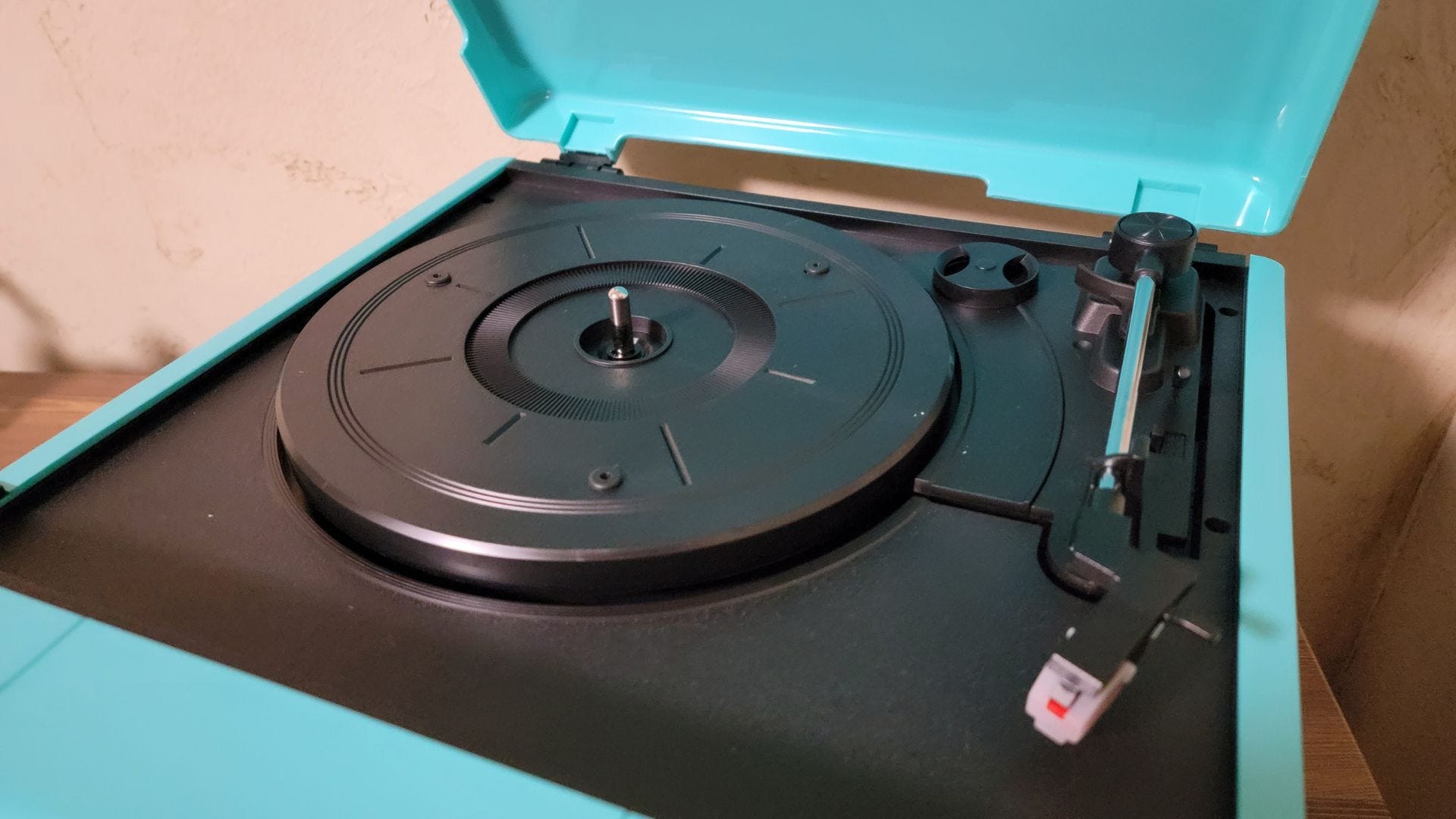
The sheer amount of functions that a single button possesses seems like it could be problematic. But most people are probably going to play records, stream music from their phone via Bluetooth, and maybe play CDs or listen to the radio.
With all the music streaming apps we have now, I can’t imagine there would be too many people wanting to record music onto a USB device, which eliminates a lot of the button confusion. That is, unless you have super old vinyl records that you want to make digital copies of. That’s the only reason I think anyone would mess with recording music from a physical format to a digital one.
Sound Quality
The speakers on this record player aren’t the best, but they’re also not horrible. What surprised me the most about the Diner’s sound quality was that increasing the volume—even all the way to its max of 32—didn’t distort the audio, whether I was playing a record or music from my phone via Bluetooth. A lot of speakers lose those musical nuances that define a song when you max out the audio, but not these. That said, somewhere between 10 and 20 volume was the sweet spot for me.

I played two records on this record player: Thank U, Next by Ariana Grande and If I Can’t Have Love, I Want Power by Halsey. Ariana’s album is clear vinyl, and Halsey’s is white-colored vinyl. I make the distinction because I’m not sure if this difference in clear versus white is responsible for the distortion I experienced on Ariana’s album.
Both albums have these bassy pop elements that came through pretty well, but not as well as they might on a premium Bluetooth speaker—which you can pair with the Diner—or a dedicated vinyl-only record player. I’d guess that both albums hit the same frequencies multiple times, but I only had major distortion issues with Thank U, Next. While trying to figure out what was going on, I came across the debated topic of whether clear or transparent vinyl sounds worse than colored or black vinyl, but there’s no solid consensus here.
When I first unboxed the Diner and set it up, I played Thank U, Next and didn’t notice any distortion that made it sound like she was singing underwater at times. But in a more recent listening session, I played If I Can’t Have Love, I Want Power first, didn’t notice any distortion, played Thank U, Next immediately after, and Ariana’s usually smooth vocals were now gurgly—but only at certain frequencies.
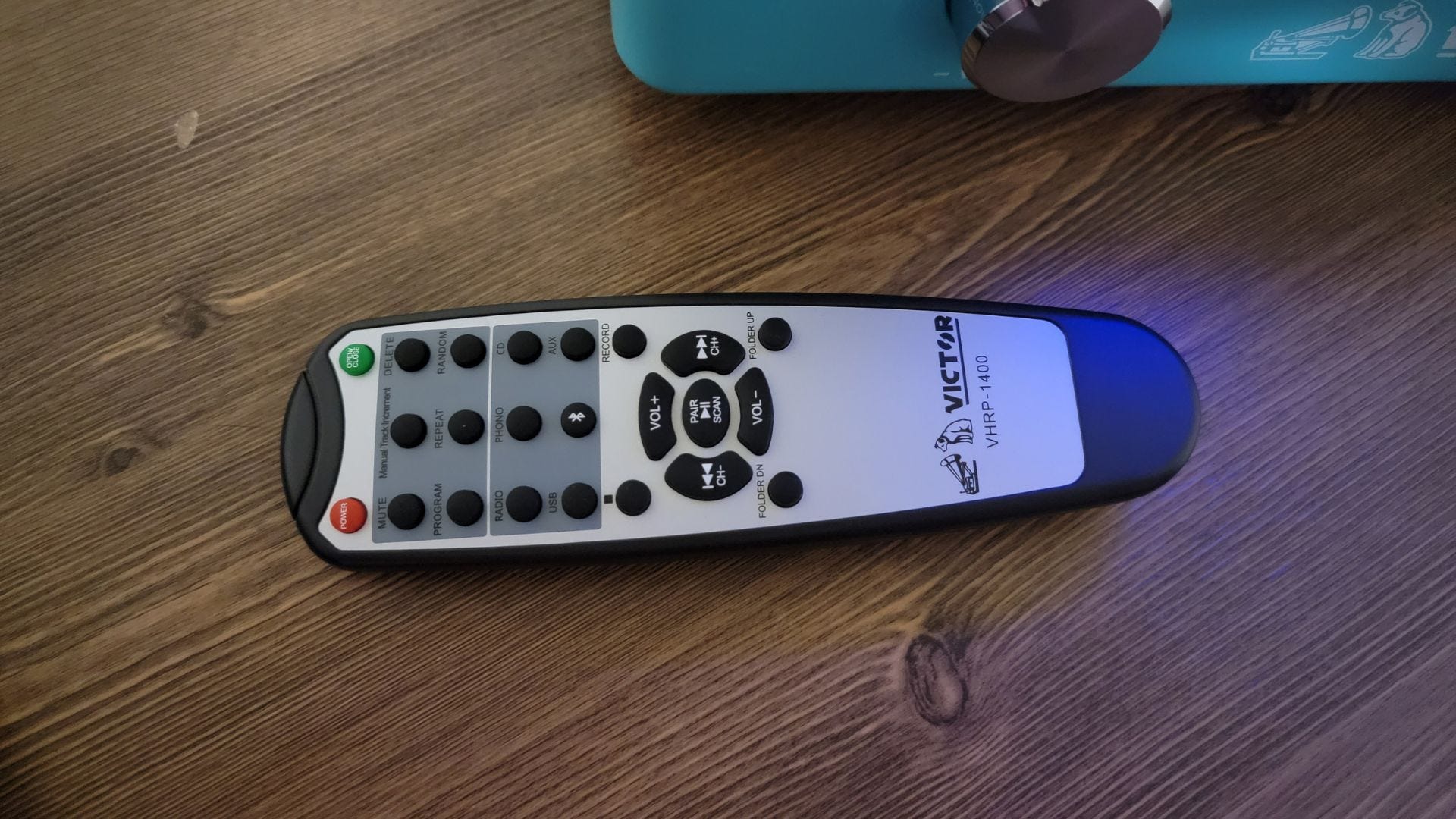
I experimented with everything I could think of—blowing air on the stylus, wiping the stylus clean with a brush, making sure the record itself was clean, and checking whether the desk I had the Diner on was level. I even went so far as to shine my phone’s flashlight on the stylus to see if there were any rogue fuzzes, and delicately pulled off the only little straggler I could see with tweezers. But still, gurgly underwater distortion!
There was one point where I tried to move the stylus slightly with my finger. I know that’s a no-no because it can break or bend so easily, but I had run out of options. I’m not sure if I accidentally did something in between unboxing the record player and now, or if there’s just something up with this stylus. Luckily, the stylus is easily replaceable and extra needles don’t cost too much, but I’m not ready to give up my troubleshooting journey just yet.
When I swapped Halsey’s album back in and started playing it, I didn’t experience any muffled sounds. After a few songs, there was one moment where she held out a note at the perfect frequency, and I heard that warbly, underwater distortion. Because of this, I’m inclined to think that it’s either an issue with the stylus, Ariana’s clear vinyl specifically (which was also way more staticky than Halsey’s album), or my desk surface not being flat enough.
Playing music from my phone via Bluetooth—even the same songs from Ariana’s album—sounded pretty good. Nothing special really, but I certainly didn’t experience any of that muffled distortion, and the sound was crisp and full enough to fill a large room well.
Verdict: Definitely Not For Audiophiles, But It’s Cute!
While I had some distortion troubles during testing, that doesn’t reflect my entire experience with the Diner Hybrid Record Player. I love that it meets modern demands of playing music via multiple formats, and at the same time, fulfills nostalgic vibes from playing vinyl records. Some people might be more attracted to a retro wood design, but I quite like the classic diner style, and I think the combination of design and good—not awesome—speakers makes it worth the investment.
Rating: 7/10
Price: $147
Here’s What We Like
- Beautiful retro design
- Multiple ways to play music
- Speakers are decent, and easily fill a room
And What We Don’t
- Outer materials feel cheap
- I had distortion troubles
